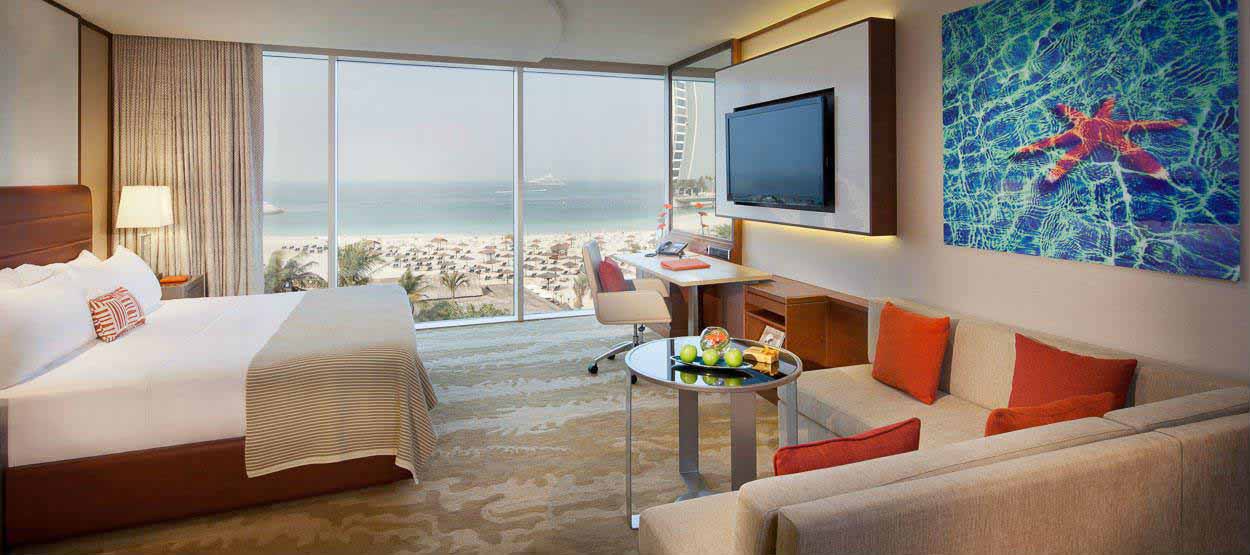Dubai set to enter top 10 global cities in hotel supply as it marks 100,000 rooms
By viji Tuesday, 10 May 2016 3:33 PM

Continued double-digit future growth ininventory critical to meet tourism demand
With Dubai set to hit the 100,000 rooms milestone next month across its expanding hotel and hotel apartment inventory, the city aims to firmly position itself as a top 10 global destination in terms of available hotel supply, indicating high demand from international travellers and sustained growth in tourism volumes. In addition to a strong historical and expected trajectory of growth in overnight visitor traffic to Dubai, the mix in travellers is shifting to show a clear preference for stays in paid accommodations, even within the Visiting Friends and Relatives (VFR) segment. This trend, coupled with an ever expanding leisure, events and attractions destination offering that seeks to draw the longer-staying family and couples segments, necessitates a simultaneous increase in room stock to bridge existing deficit and ensure supply enables stronger tourism growth.
Over the next three years, Dubai’s Department of Tourism and Commerce Marketing (Dubai Tourism) expects occupied room nights in hotels and hotel apartments to reach 36.9 million, representing an 11-12% compound annual growth rate (CAGR) to 2018 end. As such, the overall room supply is expected to reflect similar growth, reaching 138,000 rooms by the end of 2018. With demand increasing, overall projected occupancy rates until 2018 are expected to be around 77% despite growth in capacity, ensuring the emirate remains a highly competitive visitation draw.In the first quarter of 2016, Dubai’s hotels saw some of the highest global rates in occupancy, RevPar and average daily rates at 85%, AED520 ($142) and AED609 ($166) respectively.
“Structurally, healthy occupancy levels are a pre-requisite to absorb increased demand without price escalation, ensuring our destination offering remains appealing to global travellers in an intensely competitive market while retaining hotel sector performance. Our projected supply needsare based on maintaining a solid occupancy threshold despite a 40% increase in capacity which is very strong for the hospitality industryand is designed to ensure that the overall economic value for Dubai continues to be enhanced,” said His Excellency Helal Saeed Almarri, Director General, Dubai Tourism.
As such, to cater for future market needs fuelled by projected increases in visitor numbers and visitation duration,as well as a tangible shift in the behaviour mix of tourists to opt for paid accommodation, Dubai Tourism forecasts the need for continued industry pipeline growth at a CAGR of 12.0% (2015-2018), in order for the destination to remain competitive. Aligned with its tourism strategy, Dubai’s destination proposition has been developing steadily, fuelled by investment from government, public and private sectors, in order to meet the target of attracting 20 million visitors per year by 2020. A number of major theme parks are due to openthis year, along with more cultural offerings including Dubai Opera House and Dubai Historical District, as well as highly diversified retail and shopping environments and a superior calendar of year-round events and festivals that will continually evolve to remain anchor attractions for larger numbers of first-time and repeat visitors.All of these developments will ultimately drive longer visitor stays.
To this end, Dubai Tourism expects to expand overall Length of Stay (hotel nights) to four days by 2018, along with the volume growth in international overnight visitors – spurred by ever-increasing air connectivity and seat capacity primarily being delivered by the emirate’s two home-grown carriers, Emirates Airline and flydubai–to deliver a multiplier effect and sustain growth in demand for hotel rooms in the coming years.
“Our 3-5 year targets for tourism traffic, specific segment mix growth and the sector’s direct GDP contribution – that is driven by length of stay and spend beyond volume – are firm, and the entire industry has been working steadily to deliver against them,” explained His Excellency.
“Infrastructure supply is a core enabler to not only create demand but also ensure that the value from the consumers we bring to Dubai is maximised. In the hotel industry, where we have traditionally witnessed a lag in supply, we are now tracking demand more actively, and our estimates are extremely prudent in that they cater for a diversified market need that will provide confidence to investors. These projections are also built on a strong consideration to maintaining solid hotel industry fundamentals,minimising risks of overcapacity, and under-utilised inventory that can impact yield, pricing and consequently diminish the sector’s returns on investments.”
Growth in hotel and hotel apartment inventory from year-end 2015 till the end of 2018 sees an expansion of properties across the classification mix, withthree and four-star properties expecting16.8% and 14.4% CAGR growth respectively, helped by Dubai Tourism-led incentives to stimulate mid-market development.For three-star properties specifically, this growth is considerably higher than the 2.9% CAGR increase for the segment witnessed from 2012-2015. At 11.6% forecasted CAGR over the same period, the five-star segment continues to maintain a steady pace of development in line with historical trends. The varying growth expectations from each sub-category of accommodation product emphasise the strategic focus to widen Dubai’s tourist base by welcoming larger volumes and attracting families and couples, with a preference for affordable accommodation for larger party sizes and longer durations, while continuing to cater for visitors seeking the luxury experiences that Dubai is synonymous with.
“Dubai has, and will continue, to be a leading luxury destination, and we continue to invest marketing spend in bringing more tourists that are seeking the high-end experience, which had facilitated the sector to invest in adding more five-star inventory despite challenging global markets. The implementation of incentive programmes was to grow three- and four-star developments and not to stall growth of five-star properties, to ensure we maintain a healthy mix and remain appealing to segments that seek value-based offeringsand will yet contribute significantly to Dubai’s GDP though in-city spending,as well as to larger groups staying for significantly longer periods. We will continue to work closely with the hotel sector on inventory development over the coming years to maintain our competitiveness and our ability to be able to better penetrate the global tourism market,” concluded His Excellency.
A number of key top-draw attractions will open in 2016, helping to further propel Dubai’s international attractiveness among longer-stay visitors, with the launch of two mega theme park projects being a primary driver. Dubai Parks & Resorts – which houses LEGOLAND Dubai, LEGOLAND Water Park, Motiongate Dubai and Bollywood Parks Dubai – is projected to attract 6.7 million visits in its first full year of operation in 2017. The company also announced the addition of the Middle East’s first Six Flags theme park, which will open in the fourth quarter of 2019.
Meanwhile, IMG Worlds of Adventure, opening in August of this year, has a capacity to welcome 20,000 visitors per day and isforecasted to attract 4.5 million visitors during its first full year of operations, with an equal split between residents and international visitors.
In addition, Dubai Safari, as well as the iconic Dubai Opera House and the theatrical residency of La Perle by Dragone at Al Habtoor City, will greatly enhance Dubai’s global appeal among families and experience seekers when they open later in 2016.
On the retail front, Dubai’s already strong offering made up of over 95 malls as well as traditional Arabian souks is scheduled to see close to 400,000 square metres of additional retail space completed in 2016. Dubai Historical District –a 1.5sq km cultural rejuvenation project being developed to enhance Khor Dubai, as well as the other historic neighbourhoods of Bur Dubai, Al Fahidi and Deira, to showcase the emirate’s heritage, particularly in the fields of trade, handicrafts and pearl diving – is also expected to be a key visitation driver in the coming years. The project will transform the area into the leading culture and heritage centre in the region, ultimately supporting Dubai’s Tourism Vision of attracting 20 million tourists
per year by 2020, by contributing 12 million visitors in its own right once the development is completed in 2019.
*Image credt: Jumeirah Beach Hotel




























Add new comment